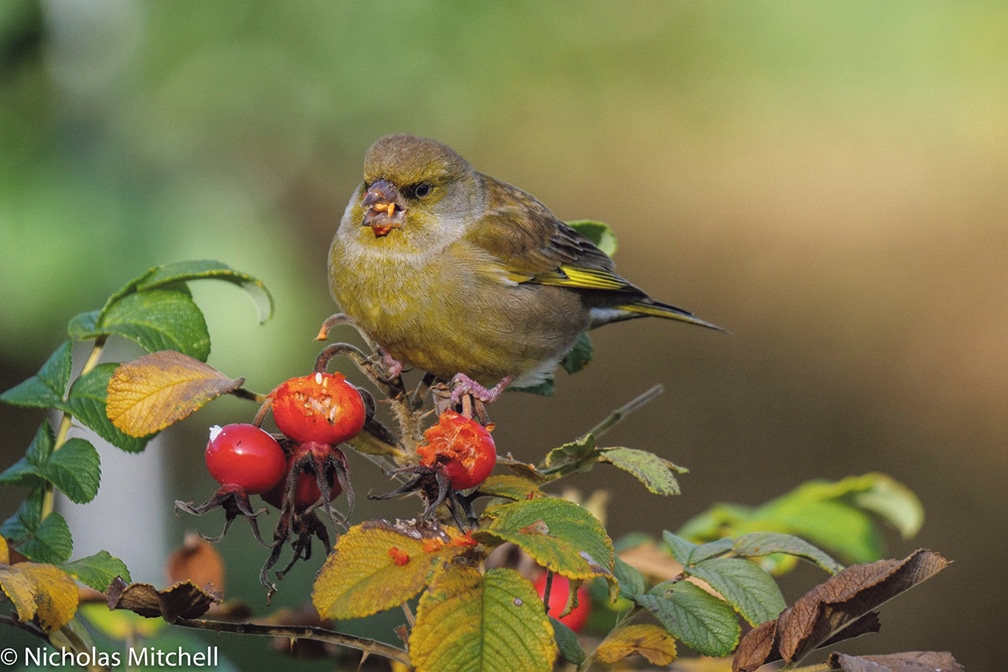
by Nicholas Mitchell
I am writing this during the third week of November. Ordinarily, bird feeders would have been placed around the garden three weeks ago, but it has been such a mild autumn that this has not been necessary. The birds have been less in need of supplementary food during this warmer spell and there is still an abundance of hips and haws on the native roses and hawthorns that we planted in the garden sixteen years ago. A non-native Cotoneaster and (I whisper this) a short hedge of Rosa rugosa also provide a good natural food source. Rosa rugosa, a rose from temperate Asia, is now deemed an invasive species in the wild so consideration needs to be given to grubbing it up some time soon. However, until that happens, its fat hips continue to be a magnate for Greenfinch, Goldfinch and House Sparrow at this time of year. Some days there are as many as twenty or more Greenfinch gorging on the seeds. And one day I may see a visiting Waxwing on the Cotoneaster.
As well as growing trees and shrubs for their berries, delaying the pruning of dead or dying branches until later in the winter, provides the birds with a foraging opportunity. Members of the Tit family can be seen and heard picking at the bark in search of invertebrates (listen out for their tap, tap, tapping). And then there is the leaf fall battle. No sooner are the paths swept clear of leaves than Blackbirds arrive to fossick about in the leaf litter and flick it back on the path in their endeavours to find food. Our mantra, especially at this time of year, is to leave large parts of the garden as ‘untidy’ as we can bear. The aim is to provide a space that provides the human inhabitants with joy and the rest of the animal kingdom with a habitat for food and shelter. This can be achieved in a garden of any size – it’s simply a matter of scale.
However, the weather forecast is indicating that we are due for frosty mornings and colder days. No doubt these will have already arrived by the time that you read this. The days also are much shorter, and that leaves less time for birds to feed. So, the feeders that were washed and stored away in April, are now back in the garden. I generally use a combination of peanuts, sunflower seeds and hearts that have a high protein and energy content and are eaten by a range of different birds. As it gets colder, I may supplement this with higher energy foods such as fat or suet balls. Apples and pears cut up and put on the lawn or a shed roof will benefit Blackbirds and, if put whole in a tree, may even attract a Blackcap that has decided to overwinter here instead of migrating south. Birds also need fresh water but make sure that it doesn’t freeze over.
Feeders are best placed within a few paces of a tree, hedge, or bush. This provides birds with both shelter and a place to escape to. If you can find a spot that can be viewed from the house, that’s a bonus. Last, but by no means least, good feeder hygiene is important. As more birds start to use your feeders, there will be an increased risk of the transfer of infection, bacteria, and parasites, such as Trichomoniasis. Scrubbing your feeders every couple of weeks using a mild five per cent bleach solution should avoid this. Let them dry completely before putting them back up.
Now you can sit back and enjoy the sight and sounds of the birds in your garden, be it on the feeders, or washing and drinking in the bird bath, or grubbing about on the ground. And, while you are doing that, why not take part in BirdWatch Ireland’s Garden Bird Survey? This is something that everyone can take part in and will also make an excellent school project. This year it runs from Monday, November 29. 2021 to Sunday, February 27, 2022. Go to birdwatchireland.ie where you can find more information and download a survey form. The Branch would love to hear about the birds in your garden, or difficulties with bird identification. You can post pictures, stories, and questions on our Facebook Page (search for @BirdWatchIrelandWestCork on Facebook or Messenger) or on Twitter @BWIWestCork.
At least for the time being, the Branch is running outings again and our next one is the Christmas walk on Tuesday, December 28, meeting at the Long Strand car park at 11am. To receive up to date news about events and, given the current situation, cancellations, join our mailing list (details below). Finally, please think about supporting the work of BirdWatch Ireland by giving a Membership as a Christmas gift or buying your feeders and high-quality bird food from the BirdWatch Ireland shop (birdwatchireland.ie/shop).
BirdWatch Ireland West Cork Branch. For more information about the Branch contact Nicholas Mitchell at secretary@birdwatchirelandwestcork.ie or join our mailing list by sending an email to mailinglist@birdwatchirelandwestcork.ie.


